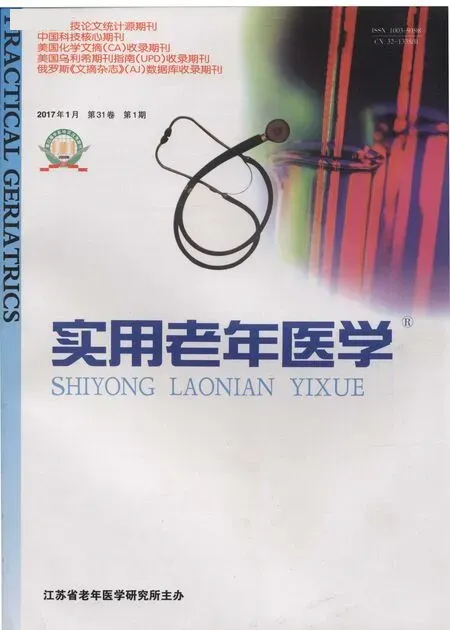胰腺導管內乳頭狀腫瘤37例診治分析
羅振國 楊萍 何曉璞 周逸嬋 朱國琴 孫為豪 邵耘
胰腺導管內乳頭狀腫瘤37例診治分析
羅振國 楊萍 何曉璞 周逸嬋 朱國琴 孫為豪 邵耘
目的 分析胰腺導管內乳頭狀黏液瘤(IPMN)的臨床及病理特征,提高其臨床診治水平。 方法 回顧性分析南京醫科大學第一附屬醫院2010年8月至2015年9月收治的37例IPMN病人的臨床資料,分析其臨床病理特征。 結果 37例IPMN病人中,男24例,女13例,平均年齡(64.13±11.62)歲;最常見的臨床表現是上腹部疼痛,共22例(59.5%);其中主胰管型16例(43.2%),分支胰管型13例(35.1%),混合型8例(21.6%);胰腺磁共振/磁共振膽胰管造影(MR/MRCP)的診斷符合率最高,為68.7%(11/16),計算機斷層掃描(CT)和超聲內鏡(EUS)的診斷符合率均為50.0%(15/30,2/4);病理診斷輕度不典型增生9例(24.3%),中度不典型增生20例(54.1%),重度不典型增生6例(16.2%),浸潤癌2例(5.4%)。不同惡性程度IPMN病人血清糖類抗原19-9(CA19-9)水平差異有統計學意義(P=0.019)。所有病人均接受手術治療,術后中位隨訪時間33月(3~72月),死亡2例,失訪13例,5年生存率達94.6%。 結論 IPMN在老年人多見,主要表現為非特異性消化道癥狀,影像學檢查陽性率有待提高,手術治療有效,預后良好。
胰腺; 導管內乳頭狀黏液瘤; 診斷; 治療
隨著對胰腺囊性腫瘤(PCNs)認識的加深及影像學技術的進步,PCNs越來越引起人們的關注。其中,胰腺導管內乳頭狀黏液瘤(IPMN)占PCNs 21%~33%,近年來發病率呈上升趨勢[1]。IPMN也稱為黏液性導管擴張,是具有潛在惡性的導管上皮源性腫瘤,病灶一般>1 cm,由分泌黏液的柱狀上皮組成,主要病變為乳頭狀增生、囊腫形成和不同程度的細胞異型性改變[2]。本研究回顧性分析南京醫科大學第一附屬醫院近5年收治的經手術確診的IPMN的臨床資料,旨在加深對IPMN的認識,提高臨床診治水平。
1 資料及方法
1.1 研究對象 全部病例來自2010年8月至2015年9月在南京醫科大學第一附屬醫院經手術治療并確診的IPMN病人共37例,其中男24例,女13例,男女比例1.8∶1,年齡27~82歲,平均(64.13±11.62)歲。>60歲者23例。
1.2 研究內容 回顧性分析所有病例的住院病史、影像學資料及手術病理資料。影像學檢查包括以下3項中至少1項:上腹部CT(平掃+增強),磁共振(MR)或磁共振膽胰管造影(MRCP),經內鏡逆行性胰膽管造影術(ERCP)。其中,CT檢查30例(81%),MR或MRCP檢查16例(43%),ERCP檢查4例(11%)。術前實驗室檢查包括白細胞(WBC)、血紅蛋白(Hb)、血小板(Plt)、中性粒細胞與淋巴細胞比值(NLR)、血型(BG)、甲胎蛋白(AFP)、癌胚抗原(CEA)、糖類抗原19-9(CA19-9)。所有病人均行手術治療。術后病理由2位病理專家審閱確認,并按照WHO分級標準分型。
1.3 隨訪 出院后采用電話隨訪3~72月。生存時間定義為從手術后到病人死亡或研究結束的時間。隨訪起始事件為開始手術治療,終點事件為病人因該病死亡。中位隨訪時間為33月,共隨訪37例,其中失訪13例,隨訪率為64.9%。

2 結果
2.1 IPMN解剖學分布 37例病人中胰頭23例(62.2%),胰頭-體3例(8.1%),胰體8例(21.6%),胰體-尾2例(5.4%),胰尾1例(2.7%);主胰管型16例(43.2%),分支胰管型13例(35.1%),混合型8例(21.6%)。
2.2 臨床癥狀及病史 37例病人中,最常見的臨床癥狀為上腹部疼痛,共22例(59.5%),其次為體質量減輕9例(24.3%),黃疸、腰背痛4例(10.8%),無明顯癥狀者12例(32.4%),為體檢或其他原因行腹部CT檢查偶然發現。
合并高血壓占35.1%(13/37),合并糖尿病的占13.5%(5/37),膽囊切除術占10.8%(4/37),慢性阻塞性肺疾病及前列腺增生各占5.4%(2/37)。有急性胰腺炎病史者占21.6%(8/37),有胃癌家族史和糖尿病家族史者各2例(5.4%),有吸煙史9例(24.3%),飲酒史4例(10.8%)。
2.3 實驗室檢查 WBC<4×109/L者6例(16.2%),Hb<120 g/L者8例(21.6%),Plt<125×109/L 者4例(10.8%),NLR>2.07 者20例(54.5%),非O型血病人11例(29.7%),CEA>4.7 ng/ml者4例(10.8%),CA19-9>37 U/ml 者7例(18.9%)。
2.4 影像學檢查 所有病人至少做過1項影像學檢查,與病理確診的IPMN比較,CT診斷符合率為50.0%(15/30),MRI或MRCP診斷符合率為68.7%(11/16),EUS診斷符合率為50.0%(2/4)。見表1。
2.5 手術及病理 所有病人均經手術治療,病理明確診斷,其中伴輕度不典型增生9例(24.3%),中度不典型增生20例(54.1%),重度不典型增生6例(16.2%),浸潤癌2例(5.4%),所有手術標本切緣均陰性,非浸潤癌病人均無淋巴結轉移。

表1 病人影像學診斷符合率比較(例)
2.6 隨訪 術后隨訪24例,1例輕度不典型增生因術后2月多臟器功能衰竭死亡,1例浸潤癌在術后33月因腫瘤全身轉移死亡,余病人無轉移或復發。所有病人1年生存率為97.3%,3年生存率為94.6%,5年生存率為94.6%。見圖1。

圖1 IPMN生存曲線圖
3 討論
IPMN由Ohashi K在1982年首次報道,此后,由于診斷水平的提高及影像學技術的進步,IPMN的檢出率逐漸增高[3]。但許多IPMN病灶較小且無癥狀,故目前IPMN的準確發病率尚未知曉。本研究顯示,IPMN的高發年齡在50~70歲,且以男性高發,與日韓等亞洲國家報道一致[4],而歐美等地女性發病率高[5],提示亞洲和歐美地區IPMN的發病率可能存在性別差異。
IPMN病人主要表現為上腹部不適、惡心、嘔吐、腹痛、背痛、厭食、體質量減輕等非特異性癥狀,部分病人可因黏液堵塞主胰管,癥狀類似胰腺炎,甚至可導致胰腺內外分泌功能不全及消化不良[6]。本研究中有8例病人既往有急性胰腺炎病史,超過一半病人因非特異性上腹痛就診,與既往報道結果相符,故對于有急性胰腺炎病史,出現不明原因上腹痛的老年病人,需考慮IPMN可能。
本組資料顯示有近1/3病人無明顯癥狀,多因其他疾病行影像學檢查偶然發現,提示IPMN的診斷需結合臨床表現、影像學檢查和手術病理等綜合判斷。建議疑似病人先行CT或MRCP檢查,仍無法確定時可進行EUS檢查。本研究結果顯示,影像學診斷陽性率為50%~68.7%,與其他報道類似[7],影像學診斷的敏感性尚待提高。
IPMN起源于胰腺導管干細胞,遵循由非浸潤性腫瘤到浸潤性癌的連續變化過程,因此盡早治療高危病人對于疾病的預后至關重要[8]。IPMN病理上表現為不同程度的胰管擴張,以胰頭部多見,胰尾部罕見,本組資料顯示,37例病人中62.2%位于胰頭。臨床上將IPMN分為主胰管型、分支胰管型及混合型。Tanaka等[8]報道主胰管型及混合胰管型IPMN進展成原位癌或浸潤癌的風險高,而多數分支胰管型IPMN進展為惡性腫瘤的過程緩慢。本研究發現的2例浸潤癌分別為主胰管型及混合型,因樣本量較小無法進一步分析浸潤癌的臨床特點。既往報道老年、女性、CA19-9升高、腫瘤直徑≥3 cm、主胰管型或混合胰管型為腫瘤惡性程度的預測因素[9-10],本研究由于樣本量限制,不同病理類型病人的臨床資料比較差異無統計學意義。雖然不同程度IPMN組間CA19-9表達水平不同(P=0.019),但CA19-9水平與IPMN惡性程度無相關關系,考慮與樣本量小有關;Fritz等[11]發現CEA與惡性程度無關,本研究發現,CEA升高的4例病人全部為中度不典型增生。
近年有學者發現血型和胰腺癌相關,非O型血病人罹患胰腺腫瘤風險高于O型血病人[12],本組資料也發現2例浸潤癌病人均為非O型血。另外炎癥在腫瘤的發生發展過程中可能起著重要作用[13],NLR被認為是系統炎癥的指標,與腫瘤的預后密切相關[14]。Kota等[15]發現在IPMN病人中,NLR>2.074為浸潤癌的獨立危險因素。本組資料中的2例浸潤癌病人NLR均>2.074。由于樣本量的限制,本研究未發現血型及NLR與IPMN的相關性。
手術是治療IPMN的重要手段,包括胰腺切除術、胰十二指腸切除術、節段腫瘤切除術等[16]。需要注意的是,IPMN術后仍有復發可能,本研究中有1例病人出現術后腫瘤多處轉移。有報道稱對于非浸潤性IPMN,剩余胰腺組織仍有≥5%的再發風險[17];而對于浸潤性IPMN,復發風險高達25%~50%[18]。因此,對IPMN病人術后需密切隨訪。
本組資料術后病人隨訪結果提示不同病理類型病人生存率存在差異(P=0.016),但與病理嚴重程度無相關關系,考慮與樣本量較小有關。IPMN手術后總體預后良好。
[1] Machado NO, Al Qadhi H, Al Wahibi K. Intraductal papillary mucinous neoplasm of pancreas[J]. N Am J Med Sci, 2015,7(5):160-175.
[2] Longnecker DS, Adsay NV, Fernandez-del CC, et al. Histopathological diagnosis of pancreatic intraepithelial neoplasia and intraductal papillary-mucinous neoplasms: interobserver agreement[J]. Pancreas, 2005, 31(4):344-349.
[3] Klibansky DA, Reid-Lombardo KM, Gordon SR, et al. The clinical relevance of the increasing incidence of intraductal papillary mucinous neoplasm[J]. Clin Gastroenterol Hepatol, 2012, 10(5):555-558.
[4] Khalid A, Brugge W. ACG practice guidelines for the diagnosis and management of neoplastic pancreatic cysts[J]. Am J Gastroenterlogy, 2007, 102(10):2339-2349.
[5] Ingkakul T, Warshaw AL, Fernandez-Del Castillo C. Epidemiology of intraductal papillary mucinous neoplasms of the pancreas: sex differences between 3 geographic regions[J]. Pancreas, 2011,40(5):779-780.
[6] Konstantinou F, Syrigos KN, Saif MW. Intraductal papillary mucinous neoplasms of the pancreas (IPMNs): epidemiology, diagnosis and future aspects[J]. JOP, 2013,14(2):141-144.
[7] Kim JH, Eun HW, Kim KW,et al. Intraductal papillary mucinous neoplasms with associated invasive carcinoma of the pancreas: imaging findings and diagnostic performance of MDCT for prediction of prognostic factors[J]. AJR Am J Roentgenol, 2013,201(3):565-572.
[8] Tanaka M, Fernandez-del Castillo C, Adsay V,et al. International consensus guidelines 2012 for the management of IPMN and MCN of the pancreas[J]. Pancreatology, 2012,12(3):183-197.
[9] Salvia R, Partelli S, Crippa S,et al. Intraductal papillary mucinous neoplasms of the pancreas with multifocal involvement of branch ducts[J]. A J Surg, 2009,198(5):709-714.
[10]Kang MJ, Jang JY, Kim SJ,et al. Cyst growth rate predicts malignancy in patients with branch duct intraductal papillary mucinous neoplasms[J]. Clin Gastroenterol Hepatol, 2011,9(1):87-93.
[11]Fritz S, Hackert T, Hinz U,et al. Role of serum carbohydrate antigen 19-9 and carcinoembryonic antigen in distinguishing between benign and invasive intraductal papillary mucinous neoplasm of the pancreas[J]. Br J Surg,2011,98(1):104-110.
[12]Handra-Luca A. Blood group type antigens in pancreatic intraductal papillary mucinous neoplasms[J]. Hepatobiliary Pancreat Dis Int, 2014,13(1):74-80.
[13]聶超,劉嘉,孫磊,等. 炎癥在前列腺癌發生發展中的作用[J]. 實用老年醫學,2015,29(4): 337-339.
[14]Mantovani A, Allavena P, Sica A,et al. Cancer-related inflammation[J]. Nature, 2008,454(7203): 436-444.
[15]Arima K, Okabe H, Hashimoto D,et al. The neutrophil-to-lymphocyte ratio predicts malignant potential in intraductal papillary mucinous neoplasms[J]. J Gastrointest Surg, 2015,19(12):2171-2177.
[16]Sohn TA, Yeo CJ, Cameron JL,et al. Intraductal papillary mucinous neoplasms of the pancreas: an updated experience[J]. Ann Surg, 2004,239(6):788-797.
[17]Kang MJ, Jang JY, Lee KB,et al. Long-term prospective cohort study of patients undergoing pancreatectomy for intraductal papillary mucinous neoplasm of the pancreas: implications for postoperative surveillance[J]. Ann Surg, 2014,260(2):356-363.
[18]Niedergethmann M, Grutzmann R, Hildenbrand R,et al. Outcome of invasive and noninvasive intraductal papillary-mucinous neoplasms of the pancreas (IPMN): a 10-year experience[J]. World J Surg, 2008,32(10):2253-2260.
Clinical analysis of 37 cases with intraductal papillary mucinous neoplasm of pancreas
LUOZhen-guo,YANGPing,HEXiao-pu,ZHOUYi-chan,ZHUGuo-qin,SUNWei-hao,SHAOYun.
DepartmentofGeriatricGastroenterology,theFirstAffiliatedHospitalofNanjingMedicalUniversity,Nanjing210029,China
Objective To analyze the clinical and pathological features of intraductal papillary mucinous neoplasm of pancreas (IPMNs), so as to improve the effect of clinical diagnosis and treatment. Methods Clinicopathological data of 37 cases with IPMN were collected in the First Affiliated Hospital of Nanjing Medical University from August 2010 to September 2015. Results Thirty-seven cases of IPMN included 24 males and 13 females, with an average age of 64.13±11.62 years old. The most common symptom was abdominal pain, with a total of 22 cases (59.5%). The main clinic type was main duct type(16 cases,43.2%), followed by branch duct type(13 cases,35.1%), and mixed duct type(8 cases,21.6%). The sensitivity for the detection of IPMN was 68.7% by magnetic resonance/magnetic resonance cholangiopancreatography (MR/MRCP), 50.0% by computed tomography(CT), and 50.0% by endoscopic ultrasonography(EUS). Pathological detection showed 9 cases of mild dysplasia, 20 cases of moderate dysplasia, 6 cases of severe dysplasia and 2 cases of invasive carcinomas. The serum level of CA19-9 in cases with different pathological types was significantly different (P=0.019). During an median of 33 months of follow-up period (3-72 months), 2 cases died and 13 cases were lost. The survival rate of five years was 94.6%. Conclusions IPMN is more common in the elderly, and is characterized by non-specific gastrointestinal symptoms. The sensitivity for the detection of IPMN by image needs to be raised. The prognosis of IPMN after the surgery is good.
pancreas; intraductal papillary mucinous neoplasm; diagnosis; therapy
江蘇省干部保健局課題資助(2013年NO.51)
210029江蘇省南京市,南京醫科大學第一附屬醫院老年消化科
邵耘,Email:yun77166@163.com
R 736.7
A
10.3969/j.issn.1003-9198.2017.01.008
2016-01-27)

